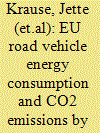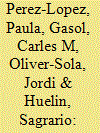|
|
|
Sort Order |
|
|
|
Items / Page
|
|
|
|
|
|
|
| Srl | Item |
| 1 |
ID:
103342


|
|
|
|
|
| Publication |
2011.
|
| Summary/Abstract |
Current policies in the road transport sector fail to deliver consistent and efficient incentives for greenhouse gas abatement (see companion article by Creutzig et al., in press). Market-based instruments such as cap-and-trade systems close this policy gap and complement traditional policies that are required where specific market failures arise. Even in presence of strong existing non-market policies, cap-and-trade delivers additional abatement and efficiency by incentivizing demand side abatement options. This paper analyzes generic design options and economic impacts of including the European road transport sector into the EU ETS. Suitable points of regulation are up- and midstream in the fuel chain to ensure effectiveness (cover all emissions and avoid double-counting), efficiency (incentivize all abatement options) and low transaction costs. Based on year 2020 marginal abatement cost curves from different models and current EU climate policy objectives we show that in contrast to conventional wisdom, road transport inclusion would not change the EU ETS allowance price. Hence, industrial carbon leakage induced by adding road transport to the EU ETS may be less important than previously estimated.
|
|
|
|
|
|
|
|
|
|
|
|
|
|
|
|
| 2 |
ID:
186444


|
|
|
|
|
| Summary/Abstract |
This paper surveys climate and energy policy in the EU transport sector covering the road, aviation, and shipping sectors. We summarise current policies, focusing on the Fit for 55 Package, and link the different instruments being used (e.g. cap-and-trade, tax, mandate, performance standard, or subsidy) to different sources of market failure. Next, we analyse the static and dynamic cost-efficiency of the policies and instruments. We find that they address a range of market inefficiencies, but that there are still a number of aspects that can further improve the cost-effectiveness of current EU climate policies in the transport sector. For example, higher taxes and emission performance standards for aviation and shipping, the right combination of research and innovation investments and learning-by-doing policies, and balancing implicit carbon prices by revising the road tax system and adding congestion tolls and charges. Finally, European policy has important side effects on the rest of the world that need to be taken into account in the selection of policies. This improved set of policies can support a sustainable recovery and reach the European Union's climate targets at the lowest cost.
|
|
|
|
|
|
|
|
|
|
|
|
|
|
|
|
| 3 |
ID:
150432


|
|
|
|
|
| Summary/Abstract |
Road transport is one of the sectors with highest energy consumptions in the planet, with large dependence of fossil fuels, and contribution for global greenhouse gas emissions. Although, Latin America is not a high-energy consumer, its share in global consumption is expected to grow, especially in the transportation sector. This make essential for developing countries the adoption of better policies to identify the vehicle groups with largest fuel demands. The present study describes the VKT technique to disaggregate road transport energy consumption by vehicle type, applied to the road transportation system of Ecuador. It also describes the procedures performed to estimate the variables required to run the model, and some of the practical applications that be used to create public policies. Results show as the biggest fuel consumers the heavy-duty freight cargo, followed by light duty vehicles. The estimation of greenhouse gas emissions evidence that road transport released 14.3 million tons of CO2 in 2012. When fuel consumption is compared by it costs, it can be confirmed that Ecuadorean Government covered, through subsidies, for 68% of the annual fuel costs of national road transport, demonstrating the importance of restructuring these expenditures in order to achieve an efficient road transport system.
|
|
|
|
|
|
|
|
|
|
|
|
|
|
|
|
| 4 |
ID:
171470


|
|
|
|
|
| Summary/Abstract |
To inform long-term policies on transport decarbonisation, the present paper analyses European road transport CO2 emission reduction options by 2050. The investigation focusses on measures improving tank to wheel vehicle efficiency, but takes into account upstream emissions of electric vehicles. Measures for vehicle efficiency improvement, transport smoothing, and transport reduction, as well as possible 2050 road vehicle fleet compositions have been quantified through expert group discussion and combined with fleet impact modelling to calculate scenario results.
Outcomes show that tank to wheel road transport CO2 emission reductions up to 90% versus 1990 could be reached by 2050 through strong fleet electrification and if all measures achieve their best potential. Under ambitious fleet electrification scenarios, CO2 reduction of more than 60% is reached without measures, but causes substantial additional demand for low-carbon electricity, the availability of which is not covered in this paper. It is likely that policies will be a prerequisite for fleet electrification and efficiency increases of the order of magnitude assumed. Moreover, upstream CO2 emissions of electricity for battery and plug-in hybrid electric vehicles could add up to 40% of tank to wheel emissions, suggesting that complementary policies are needed to avoid shifting transport emissions to other sectors.
|
|
|
|
|
|
|
|
|
|
|
|
|
|
|
|
| 5 |
ID:
124603


|
|
|
|
|
| Publication |
2013.
|
| Summary/Abstract |
The current increasing importance of road transport in the overall greenhouse gas (GHG) emissions has led to the adoption of diverse policies for the mitigation of global warming. These policies focus in two directions, depending on whether they involve the reduction of emissions or the mitigation through carbon dioxide (CO2) sequestration. In this paper, the Tier 3 methodology from the European Monitoring and Evaluation Programme and the Environment Agency (EMEP/EEA) was applied to determine the evolution of Spanish motorway GHG emissions in the period 2005-2010. According to the results, though the average daily traffic (ADT) is the major parameter, the average fleet age and vehicle size also affect the level of emissions. Data analysis also revealed a clear connection between the decrease in European trade volume during the financial crisis and the GHG release, despite its temporary character. Among the three improvement scenarios evaluated, reduced speed limit seems the most direct measure while the consequences of afforestation strongly depend on the traffic density of the stretch of the motorway considered. Finally, technological improvement requires a drastic change in the fleet to obtain substantial decrease. The combination of different policies would allow a more robust strategy with lower GHG emissions.
|
|
|
|
|
|
|
|
|
|
|
|
|
|
|
|
| 6 |
ID:
128371


|
|
|
|
|
| Publication |
2014.
|
| Summary/Abstract |
In-use fuel consumption data of 924 passenger cars (611 petrol, 313 diesel) were collected from various European sources and were evaluated in comparison to their corresponding type-approval values. The analysis indicated that the average in-use fuel consumption was higher than the type-approval one by 11% for petrol cars and 16% for diesel cars. Comparison of this dataset with the Travelcard database in the Netherlands showed that the deviation increased for late model years and in particular for cars with low type-approval values. The deviation was higher than 60% for vehicles registered in 2012 within the 90-100 gCO2/km bin. Unrealistic vehicle resistances used in type-approval were identified as one of the prime reasons of the difference. A simplified linear model developed in the study may be used to predict in-use fuel consumption based on data publicly available. The model utilizes the fuel consumption measured in type-approval, the mass, and the engine capacity to provide in-use fuel consumption. This may be either used to correct fuel consumption factors currently utilized by emission models (e.g. COPERT, HBEFA, VERSIT+, and others) or could be used independently to make projections on how fuel consumption may develop on the basis of changing future passenger cars characteristics.
|
|
|
|
|
|
|
|
|
|
|
|
|
|
|
|
| 7 |
ID:
069818


|
|
|
| 8 |
ID:
193747


|
|
|
|
|
| Summary/Abstract |
Decarbonizing road transport – through electrification, public transport, and walking and biking – can be a net social benefit thanks to reduced congestion, accidents, air pollution, and energy costs. However, governments face losing fuel and vehicle tax revenue. We develop for the first time a method to assess options to maintain fiscal revenues without hampering decarbonization benefits for firms and households. We estimate the financial impact of transport decarbonization on the government, firms (buses, taxis, freight, and other private uses), and households grouped by income level and region of residence. Then, we evaluate how the government can use energy, property, import, and distance-based tax adjustments to compensate for the fiscal cost of decarbonization, and the incidence of these adjustments on firms and households. We apply the method to Costa Rica, a country committed to reaching net-zero emissions by 2050 and where 20% of government revenue comes from transport taxes. Decarbonizing transport would cause a fiscal impact of −0.41% of GDP on average between 2023–50, which is lower than the financial benefits on households and firms: +1.49% of GDP. We show that a combination of tax adjustments would eliminate the fiscal impact while maintaining net benefits for all firms and households of all income levels and regions of residence.
|
|
|
|
|
|
|
|
|
|
|
|
|
|
|
|
| 9 |
ID:
133293


|
|
|
|
|
| Publication |
2014.
|
| Summary/Abstract |
Road transport in India plays a vital role in our growing economy. Given an aggressive vehicle sales outlook through 2030, in order to maintain a balance between the energy demand, growing on-road emissions, and overall air quality in the cities, there is a need to implement and enforce Bharat-5 standards (equivalent of Euro-V) nationwide by 2015. Any delay in its implementation or even staggered implementation of the standards will result in a delayed response for improving air quality in the Indian cities.
|
|
|
|
|
|
|
|
|
|
|
|
|
|
|
|
| 10 |
ID:
097202


|
|
|
|
|
| Publication |
2010.
|
| Summary/Abstract |
The rapid growth of vehicles has resulted in continuing growth in China's oil demand. This paper analyzes future trends of both direct and life cycle energy demand (ED) and greenhouse gas (GHG) emissions in China's road transport sector, and assesses the effectiveness of possible reduction measures by using alternative vehicles/fuels. A model is developed to derive a historical trend and to project future trends. The government is assumed to do nothing additional in the future to influence the long-term trends in the business as usual (BAU) scenario. Four specific scenarios are used to describe the future cases where different alternative fuel/vehicles are applied. The best case scenario is set to represent the most optimized case. Direct ED and GHG emissions would reach 734 million tonnes of oil equivalent and 2384 million tonnes carbon dioxide equivalent by 2050 in the BAU case, respectively, more than 5.6 times of 2007 levels. Compared with the BAU case, the relative reductions achieved in the best case would be 15.8% and 27.6% for life cycle ED and GHG emissions, respectively. It is suggested for future policy implementation to support sustainable biofuel and high efficient electric-vehicles, and the deployment of coal-based fuels accompanied with low-carbon technology.
|
|
|
|
|
|
|
|
|
|
|
|
|
|
|
|
|
|
|
|
|